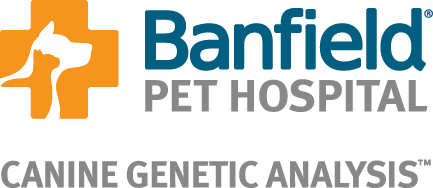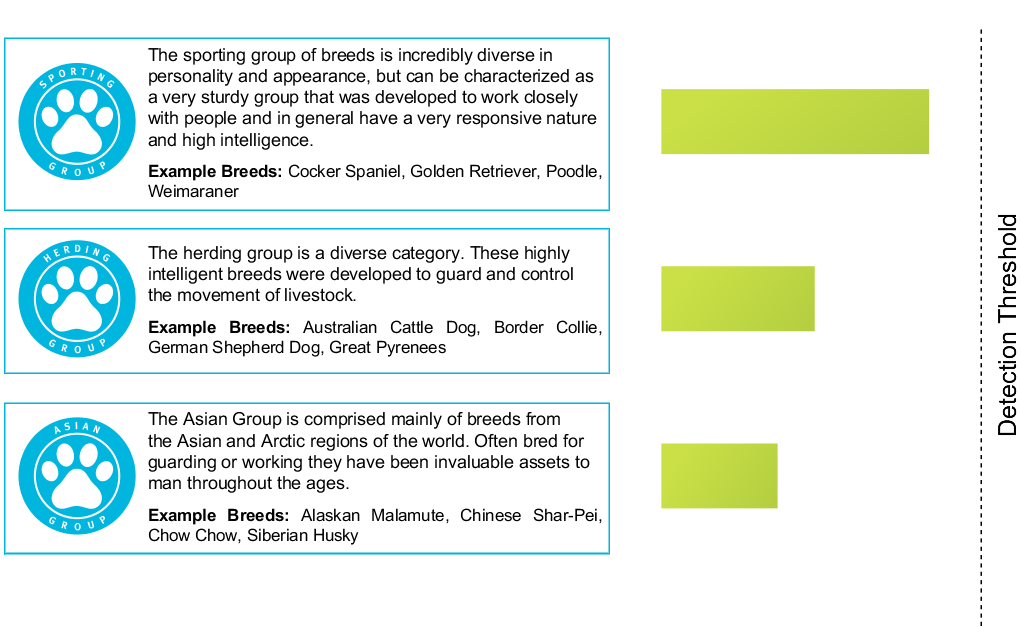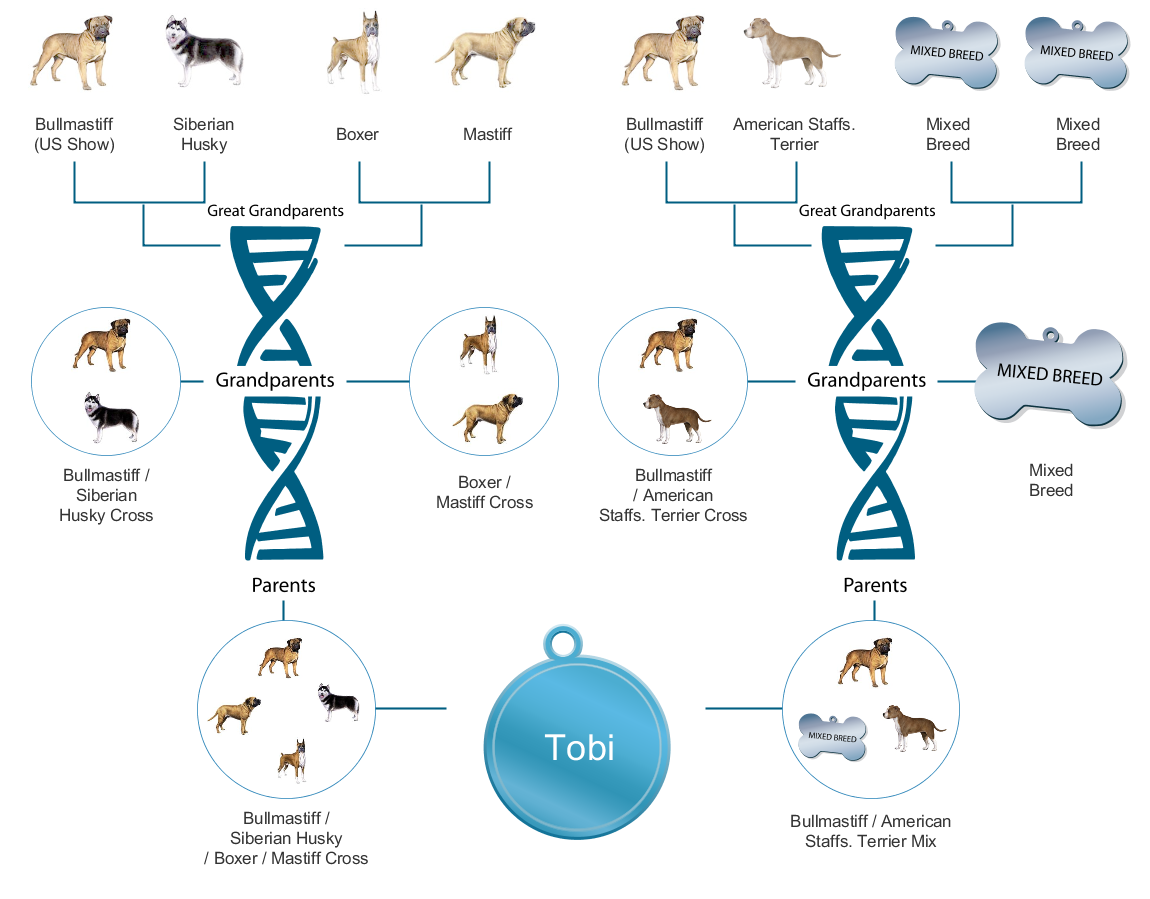
Canine Genetic Analysis™ for Tobi
Owner: Naythan Jones
Report ID: 00BAN_5078MARS0000A
Dr. Allison Nicole Nunn
Banfield Pet Hospital #5078
26548 Moulton Parkway, Ste G,
Laguna Hills, CA 92653-6200
Fax: (949) 448-0372
| ||
|
Findings
| |||||||||||||
|
Report Summary
The Banfield® Canine Genetic Analysis™
analyzed
Tobi’s DNA for more than 140 specific
disease mutations, and provides a predicted weight range and a three-generation ancestry chart to help you craft a personalized
care plan for Tobi supporting the five elements of preventive care. You can find detailed analyses in this
report. We have provided this summary to help you set up the next Optimum Wellness Plan® for
Tobi:
We recommend the Active Prevention Optimum Wellness Plan for
Tobi
| |||||||||||||
|
Optimum Wellness Plan®: What’s Next?
| ||
|
Optimum Wellness Plan Recommendation for Tobi
You and your client know Tobi best. The Canine Genetic Analysis™ is important,
but it is only one indicator you
will use in recommending the appropriate wellness plan level for next year.
Talk to your client at the next
comprehensive exam to discuss the Canine Genetic Analysis™ recommendation
of Active Prevention Plan
for next year.
The most common disease in dogs is dental disease. It affects 91% of dogs over the age of three. Like humans,
dental disease has been associated with changes in liver, kidney and cardiac functions. Based on
Tobi’s breed
and age, we know that your client’s pet would greatly benefit from a dental cleaning BEFORE these problems develop. Twice-yearly
comprehensive physical exams include blood work. As a Banfield veterinarian, you will be able to establish baselines for
Tobi
so you can watch for problems that might appear with age. Clients should talk to their veterinarian for more detail about what is
included in the Active Prevention Plan.
Nutrition
Weight and nutritional counseling are part of the comprehensive physical exam(s) included in every Optimum Wellness Plan.
This will be especially important as Tobi matures. Based on test results,
we predict Tobi’s ideal weight range to be:
Ideal Weight Range: 76 - 120 lbs
Dental Care
Discuss dental care with your client. Describe how professional teeth cleaning prevents serious infection, tooth loss, pain and may reduce the
potential for heart and kidney disease. You should also discuss how we always thoroughly assess clients’ dog’s health before administering
anesthesia for any dental procedure.
Vaccinations
Discuss how Optimal Wellness Plans protect your client’s pet against a wide variety of diseases and infections with routinely
recommended vaccinations to meet a dog’s individual needs.
Parasite Control
Review the parasite control options that can be added to any Optimum Wellness Plan to make it easy and affordable
to protect their dog from fleas, heartworm and other parasites that can spread harmful diseases.
Behavior
Work closely with your client and their pet to help develop behavior training plans.
| ||
|
MDR1 Results
| |||||||||||||||||||
|
MDR1 Screening Results
Test Results Analysis
MDR1 Normal/Normal - These dogs do not have the MDR1 mutation. They will not pass on the mutant gene to their offspring.
About MDR1
MDR1, or Multidrug Resistance-1 is a genetic mutation found in many of the herding breeds, some sighthound breeds
and many mixed-breed dogs. The MDR1 gene is responsible for production of P-glycoprotein, which is a transport pump
that plays an important role in limiting drug absorption and distribution (particularly to the brain), and in
enhancing the excretion of many drugs used in dogs.
Some dogs, particularly herding breeds or mixed-breed dogs with herding breed ancestry, may have a mutation
in the MDR1 gene that impairs the dog’s ability to limit the absorption and distribution of many drugs.
These dogs are also slower to eliminate drugs from the body that are normally transported by P-glycoprotein.
All dogs have two copies of this gene, and dogs with mutations in both copies will be much more sensitive to
some commonly used drugs. Even dogs with only one copy of the mutation, however, are more sensitive to drugs
than dogs with two normal MDR1 genes. Therefore, it is helpful to talk to your clients about this testing opportunity
so that you can provide your canine patients with the best possible care.
What about Mixed-breeds?
Our test looks for the presence of purebreds in a dog’s heritage back to the great-grandparent level. Just because we don't
find a purebred herding breed in the dog’s last three generations, doesn't mean he or she doesn’t have one further back in
their ancestry. Therefore, all mixed-breed dogs should be tested for the MDR1 mutation.
Clinical Considerations for MDR1 Results
There is currently no agreement among veterinarians and veterinary anesthesiologists regarding changes in medication dosing
(including anesthetic medications) for dogs that carry the MDR1 (also known as ABCB1) mutation. It is always recommended
to monitor pets closely for any unexpected side effect of any medication, including anesthetic agents. Dr. Katrina Mealey
(Washington State University) currently recommends a 25% reduction in acepromazine and butorphanol in nor/mut genotypes
and a 50% reduction in mut/mut genotypes. However, these recommendations are only general guidelines and should not be
considered a Banfield standard of care at this time. All anesthetic agents should be dosed to effect and close pet
monitoring remains crucial.
It is always up to the veterinary team to determine the most appropriate pharmaceutical option for their patients.
Owners of pets with an MDR1 mutation should be educated about risks of all medications (list provided). It is recognized
that dosing of FDA approved macrocyclic lactone-containing heartworm preventatives does not need to be altered in pets
with MDR1 mutations (1-3). Higher dosages of these compounds (eg. for treatment of demodectic mange) should be used
cautiously in these pets.
Take each pet's unique history, prior pharmaceutical history, and concurrent medications into account.
Consider consultation with a veterinary specialist as appropriate.
For More Information About MDR1
For more information about MDR1 contact Mars Veterinary at 1-888-597-3883 or customercare@marsveterinary.com,
Or visit the Washington State University School of Veterinary Medicine at
http://vcpl.vetmed.wsu.edu/.
MDR1 Genetic Screening Information
Origins of the Test
The discovery of the mutation of the multidrug resistant gene (MDR1) and its effects on multidrug sensitivity
in dogs was made by Washington State University. It is a patent-protected diagnostic test offered by
Washington State University that has been licensed to Mars Veterinary for use in the Banfield® Canine Genetic Analysis™ tests.
Technology Licensed By

References
|
|||||||||||||||||||
|
What We Found
| ||||||||||||||||||||||||||||||||||||||||||||||||||||||||||
|
Results for Tobi’s Genetic Mutations Screening
As part of the Canine Genetic Analysis™, Tobi was tested for more than 140 genetic mutations
which are associated with different conditions.
This information is not intended to diagnose disease or predict
behavior in any particular dog, but is provided for the veterinarian’s information only so you can advise your client on
the potential need for follow up testing for specific disease conditions.
For more information about these and all the diseases that the Canine Genetic Analysis™ tests for, please visit http://marsveterinary.force.com/banfieldcga.
These genetic health screens were developed in partnership with Genoscoper®
Laboratories (www.genoscoper.com) for use in the Banfield® Canine Genetic Analysis™
test.
 | ||||||||||||||||||||||||||||||||||||||||||||||||||||||||||
|
|||||||||
|
|
Genealogy
| ||
|
A Note on Mixed Breeds
A portion of Tobi’s ancestry was predicted to be mixed beyond three generations. It is difficult
to identify strong individual breed signals in this mixed portion, so we have listed the genetic breed
groups with the strongest statistical likelihood below. The genetic breed groups are listed by relative
strength with the most likely at the top of the list.
 | ||
|
Genetic Heritage
| ||
|
Genetic Heritage
Genetic heritage can affect
Tobi’s appearance,
behavior and health. We have provided some
general information about the breeds detected in Tobi
in the client report.
You should discuss any health related concerns with your client. The purpose of the Canine Genetic
Analysis™ is to identify Tobi’s genetic ancestry
and to provide information to
help craft a personalized care plan to help provide the best quality of life for
Tobi.
How Canine Genetic Analysis Works
The DNA extracted from Tobi’s cells was
examined for over 3000 markers that are used in the test.
These results were evaluated using a program designed to consider all possible pedigree trees from the
last three generations, from a simple pedigree with a single breed (likely a pure bred) to a complex tree
with eight different great-grandparent breeds allowed.
We use information from over 250 breeds, varieties, and types from our breed database to fill these
potential pedigrees. Each of the millions of pedigrees are scored on how well it matches
Tobi’s
data. The pedigree with the best score is shown on the ancestry chart.
Terms and Conditions
Each dog is unique and its physical and behavioral traits will be the result of multiple factors, including
genetics, training, handling, and environment. Banfield® Pet Hospital’s proprietary Canine Genetic
Analysis™ provides insight into the behavioral traits in breeds that have been identified in a dog, the
predicted genetic adult weight range and breed-related risks of developing certain genetic diseases. A
dog’s weight range can vary significantly depending on age, diet and exercise. Canine Genetic Analysis™ is
not intended to diagnose any disease or predict behavior in any particular dog.
In the unlikely event that it is not possible to determine breed history, predicted adult weight range or
breed-related health risks, or if an error in the analysis occurs, liability by Banfield® Pet Hospital, or
related companies and individuals is disclaimed and damages in any event are limited to the payment
actually received by Banfield for the individual specified analysis at issue.
Canine Genetic Analysis™ is designed and intended to be used solely to identify the genetic history of a
dog’s recent ancestry and no other purpose is intended, authorized or permitted.
All dogs should be considered individual animals. Because each dog is a product of its unique environment and handling,
it may exhibit different traits and behaviors than those listed on the breed detail pages provided in the final results.
The descriptions of the individual breeds provided by the Banfield Canine Genetic Analysis on these pages are intended to be
general in nature. They are not intended to be all-inclusive or definitive and may or may not reflect the natural temperament of your dog.
Many countries and provinces have breed-specific ordinances and laws that may require special handling
or prohibit the ownership of some dogs with a particular breed in their genetic background. Canine
Genetic Analysis™ is not intended to be used by regulatory or animal control officials to determine whether
a particular breed is legislated or banned in a particular community. Nor is Canine Genetic Analysis™
intended to be used in any judicial proceedings. Rather, it is intended to be used as a tool or resource in
determining a dog’s genetic history. Neither Banfield Pet hospital nor any related company is responsible
for compliance or notification regarding these matters.
Banfield® Pet Hospital continues to study the complexities of the canine genome, with the goal of
continuing to add breeds and the ability to detect additional breed-related disease conditions to Canine
Genetic Analysis™ in the future.
If you have any questions about the results, please contact Mars Veterinary
at:
888-K9-PET-TEST (1-888-597-3883).
| ||

